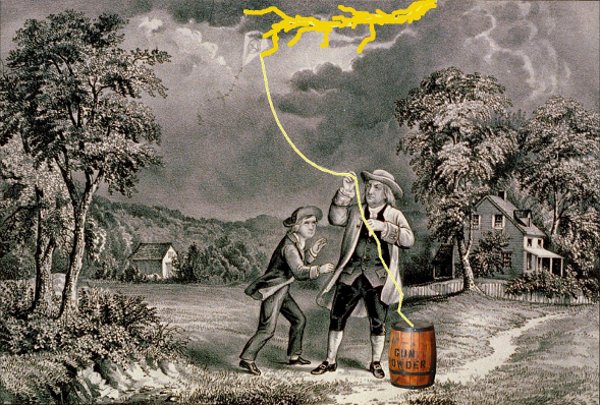Weak Sparks Need Not Apply
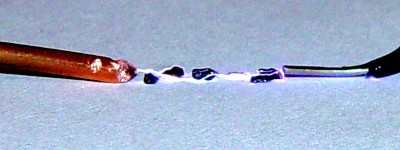 Experiments performed a few years ago
and shown on the web page here
found that weak sparks, such as from static electricity, are incapable of igniting black powder. Since I wanted
to use smokeless powder in the rifle, and since it has a much higher ignition point than the black powder shown
here, my first attempts used sparks from a stun-gun to see if they could ignite the powder.
Experiments performed a few years ago
and shown on the web page here
found that weak sparks, such as from static electricity, are incapable of igniting black powder. Since I wanted
to use smokeless powder in the rifle, and since it has a much higher ignition point than the black powder shown
here, my first attempts used sparks from a stun-gun to see if they could ignite the powder.
Even Strong Sparks Are Wimpy
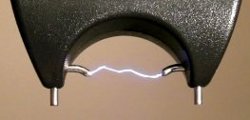 The stun gun shown here is advertised as producing a 100,000 volt spark. The sparks
were certainly loud and impressive, and they easily burned tiny holes through a piece of paper placed between the
electrodes, but would they ignite powder?
The stun gun shown here is advertised as producing a 100,000 volt spark. The sparks
were certainly loud and impressive, and they easily burned tiny holes through a piece of paper placed between the
electrodes, but would they ignite powder?
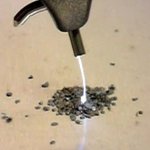
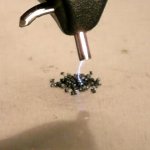 Hundreds of sparks were struck into a pile of
Hodgdon's Tite-Group smokeless powder (left) and Swiss black powder (right) with absolutely no effect except
for bouncing the grains around. The sparks were striking the grains, and you can see flashes when the spark hits
the surface of the granules, but never once would the powder ignite!
Hundreds of sparks were struck into a pile of
Hodgdon's Tite-Group smokeless powder (left) and Swiss black powder (right) with absolutely no effect except
for bouncing the grains around. The sparks were striking the grains, and you can see flashes when the spark hits
the surface of the granules, but never once would the powder ignite!
The photo below shows a spark from the stun gun going completely through a line of black powder stuck to a piece
of masking tape, and although hundreds of grains were simultaneously hit, nothing happened.

Corraling The Granules
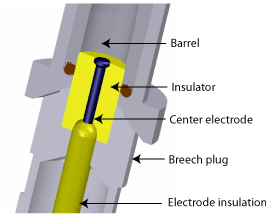
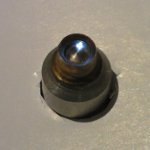 My first thought was that the granules were simply being blown out of the way, and if
the powder was confined (loosely packed) in a breech, they would be held in place and therefore ignite. To
accomplish this, a breechplug was made with a spark-plug like tip. An insulator was cut from ZTA ceramic
("ceramic steel"), and contained a central electrode connecting to the spark source - in this case, the
stun gun. As you can see here on the right, there are nice, hot sparks inside the collar, which is used here as a
substitute for a barrel.
My first thought was that the granules were simply being blown out of the way, and if
the powder was confined (loosely packed) in a breech, they would be held in place and therefore ignite. To
accomplish this, a breechplug was made with a spark-plug like tip. An insulator was cut from ZTA ceramic
("ceramic steel"), and contained a central electrode connecting to the spark source - in this case, the
stun gun. As you can see here on the right, there are nice, hot sparks inside the collar, which is used here as a
substitute for a barrel.
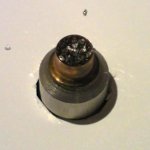 However, when the smokeless powder was packed into the space around the
electrode, passing sparks through it as seen here had no effect. Some granules were 'popped' up into the
air, and a faint spark can be seen under the powder, but nothing else happened. The same thing was tried with
black powder, but still no ignition. My conclusion was that it is virtually impossible to set off gunpowder -
either smokeless or black powder - with any type of spark source. However, there is an electrically fired muzzle
loader, the CVA® Electra TM, so there must be a way of doing it.
However, when the smokeless powder was packed into the space around the
electrode, passing sparks through it as seen here had no effect. Some granules were 'popped' up into the
air, and a faint spark can be seen under the powder, but nothing else happened. The same thing was tried with
black powder, but still no ignition. My conclusion was that it is virtually impossible to set off gunpowder -
either smokeless or black powder - with any type of spark source. However, there is an electrically fired muzzle
loader, the CVA® Electra TM, so there must be a way of doing it.
Resistance Ignition
My first venture into electrically fired rifles was this black powder breechloader with electric ignition. It uses the conductive properties
of graphited black powder to heat the granules to ignition with a 300 volts from a photo flash capacitor.

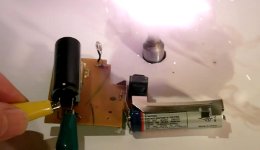 As voltage is applied to the black powder packed in the chamber
around the electrode, the current flows through the graphite coating of the granules and heats them to their
ignition point. The current source used in that rifle is a 330volt 120 μfd photo flash capacitor, which can
hold about five watt-seconds of energy - plenty of power to heat up that small amount of powder. Because the
current is dumped so quickly, the ignition is instantaneous. The photo to the left is of about one grain of Swiss
BP being fired using this principle. However, this will not work with smokeless powder since it is practically
non-conductive.
As voltage is applied to the black powder packed in the chamber
around the electrode, the current flows through the graphite coating of the granules and heats them to their
ignition point. The current source used in that rifle is a 330volt 120 μfd photo flash capacitor, which can
hold about five watt-seconds of energy - plenty of power to heat up that small amount of powder. Because the
current is dumped so quickly, the ignition is instantaneous. The photo to the left is of about one grain of Swiss
BP being fired using this principle. However, this will not work with smokeless powder since it is practically
non-conductive.
Alternate(ing) Approach
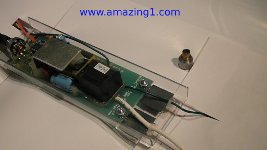
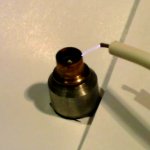 The image to the left shows a high voltage power supply which can run off a 12 volt battery and puts out 7,000
volts of high frequency alternating current. It can deliver about seven watts, and the arc it produces is very
'smooth' and does not displace the powder granules. The photo to the right shows an arc that can be
struck from its 'hot' wire.
The image to the left shows a high voltage power supply which can run off a 12 volt battery and puts out 7,000
volts of high frequency alternating current. It can deliver about seven watts, and the arc it produces is very
'smooth' and does not displace the powder granules. The photo to the right shows an arc that can be
struck from its 'hot' wire.
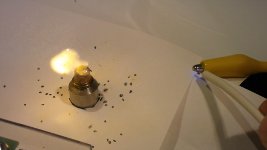 Here is a
test of the HVAC system setting off smokeless powder in the test fixture. On the upper right side of the image
you can see the spark jump to the clip, where it then travels to the igniter and sets off the powder. This is the
system I used in the fourth version of my rifle, and it very effectively sets off the smokeless powder charge -
but with one 'small' hitch... Because the power from the supply can't be delivered in one quick
burst, it takes a perceptible delay between the trigger contact and firing - more like a slow flintlock than the
instantaneous firing that I wanted, so I continued to experiment to find a solution to that problem.
Here is a
test of the HVAC system setting off smokeless powder in the test fixture. On the upper right side of the image
you can see the spark jump to the clip, where it then travels to the igniter and sets off the powder. This is the
system I used in the fourth version of my rifle, and it very effectively sets off the smokeless powder charge -
but with one 'small' hitch... Because the power from the supply can't be delivered in one quick
burst, it takes a perceptible delay between the trigger contact and firing - more like a slow flintlock than the
instantaneous firing that I wanted, so I continued to experiment to find a solution to that problem.
Wimpy Sparks on Steroids
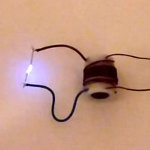 Although the resistance heating provides
instant ignition, since smokeless powder (and most BP substitutes) don't conduct electricity, they won't
work in this scenario. However, if we can 'coax' the charge from the photo flash capacitor through a
non-conductive powder in the igniter, this might be enough to set it off, and there is a neat trick to do this.
Once an electric spark is started in air, the ionization created greatly lowers its electrical resistance, and in
theory, it should allow the energy from the capacitor to follow along, converting a weak spark into a real
powerhouse.
Although the resistance heating provides
instant ignition, since smokeless powder (and most BP substitutes) don't conduct electricity, they won't
work in this scenario. However, if we can 'coax' the charge from the photo flash capacitor through a
non-conductive powder in the igniter, this might be enough to set it off, and there is a neat trick to do this.
Once an electric spark is started in air, the ionization created greatly lowers its electrical resistance, and in
theory, it should allow the energy from the capacitor to follow along, converting a weak spark into a real
powerhouse.
Here is a small spark coil I wound (directions below) which, when powered by discharging a small capacitor
through the outer primary windings, produces enough voltage in the inner secondary windings to jump the gap in
the igniter. The spark shown here, although it looks bright, is not very powerful and can't set off any
powder by itself. However, if we hook this coil in series with the photo flash capacitor, the current from the
capacitor will flow through the coil and across the gap bridged by the spark, hopefully turning a 'wimpy'
spark into a real banger which will set off the powder.
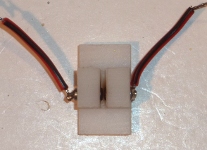 Just one little problem with the augmented spark
configuration was that the voltage from the capacitor (now 550 volts) was always present on the igniter and thus
could have been a severe safety problem. Also, it meant that any conductive powder might be instantly fired as
soon as it was added, so I had to include one more component, a spark-gap switch in series with the igniter. The
switch is nothing more than a pair of 1/8 inch stainless steel electrodes held just far enough apart so the
capacitor voltage can't jump the gap all by itself, in this case, about 0.020". When the trigger spark
is set off, it jumps the switch gap as well as the igniter, and the current flows through everything, but until
the trigger spark goes off, the igniter is 'disconnected' from the voltage source, keeping everything
safe.
Just one little problem with the augmented spark
configuration was that the voltage from the capacitor (now 550 volts) was always present on the igniter and thus
could have been a severe safety problem. Also, it meant that any conductive powder might be instantly fired as
soon as it was added, so I had to include one more component, a spark-gap switch in series with the igniter. The
switch is nothing more than a pair of 1/8 inch stainless steel electrodes held just far enough apart so the
capacitor voltage can't jump the gap all by itself, in this case, about 0.020". When the trigger spark
is set off, it jumps the switch gap as well as the igniter, and the current flows through everything, but until
the trigger spark goes off, the igniter is 'disconnected' from the voltage source, keeping everything
safe.
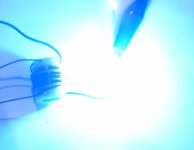
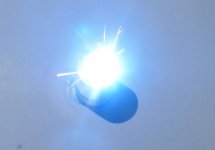 The results are seen to the left,
with a spark in air - just like the unaugmented spark above. To the right is a photo of an augmented spark in the
igniter. The spark is hot enough to blow off pieces of the electrode! Now, if we add a little smokeless powder,
it should finally ignite - shouldn't it?
The results are seen to the left,
with a spark in air - just like the unaugmented spark above. To the right is a photo of an augmented spark in the
igniter. The spark is hot enough to blow off pieces of the electrode! Now, if we add a little smokeless powder,
it should finally ignite - shouldn't it?
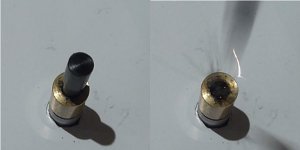 Here, a small smokeless powder charge was placed
into the collar and held down with a light plastic 'tamper' so the granules would stay in place when the
spark hit. The right-hand side of the image shows what happened when the spark was fired - the concussion from
the spark blew the tamper out and scattered powder granules all over, but the powder still didn't
light!
Here, a small smokeless powder charge was placed
into the collar and held down with a light plastic 'tamper' so the granules would stay in place when the
spark hit. The right-hand side of the image shows what happened when the spark was fired - the concussion from
the spark blew the tamper out and scattered powder granules all over, but the powder still didn't
light!
About this time I was ready to give up, but after a few days of reflection, I thought I knew what was happening. The spark in the chamber was clearly extraordinarily hot and was vigorous enough to blow the tamper out of the chamber, which meant that the air in the chamber had to be heated to a high temperature. But why didn't the powder ignite? I believed the reason was the extremely brief duration of the spark; in trying to capture it on a video, it was so brief that it took many tries to accidentally capture a video frame on a camera running 30 frames/second. My guess is that it lasted only a few micro seconds, and thus, no matter how hot it was, it couldn't transfer enough heat into the powder granules during this brief time period for them to ignite. Therefore, slowing down the spark, even if it meant reducing its intensity, might be enough to do the job.
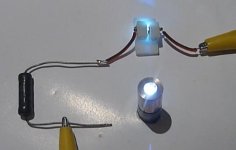 To slow down the spark, I simply added a
resistor in series with the capacitor so the current was limited to about two amperes - which is still a lot of
current going through a spark. As you can see from the image,the spark was much brighter than from the spark coil
alone, but was very much less intense than without the resistor. However, it seemed to last a bit longer - about
2000 micro seconds, so that elongation might do the trick.
To slow down the spark, I simply added a
resistor in series with the capacitor so the current was limited to about two amperes - which is still a lot of
current going through a spark. As you can see from the image,the spark was much brighter than from the spark coil
alone, but was very much less intense than without the resistor. However, it seemed to last a bit longer - about
2000 micro seconds, so that elongation might do the trick.
Success, Finally!
I added some smokeless powder (this time without a tamper) and sparked it. It worked! Not only did it
work for the Tite Group smokeless powder, but for all others I tried, and all ignitions were instantaneous.
Hodgdon 'TiteGroup' Smokeless 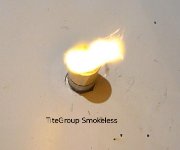
777 Black Powder Substitute 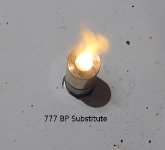
Shockleys Gold 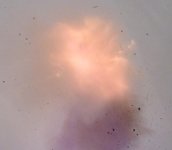
Goex Black Powder 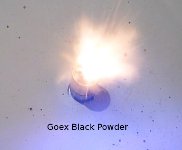
Onward...
After I clean up my mechanical drawings and publish this material, I plan to incorporate this new ignition system into my caseless ammunition .22 rifle - which will also be published with a video when it is finished.
Details, Details...
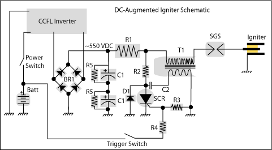 For those
readers who insist on risking life and limb duplicating these results, a document containing the schematic and
other construction details can be had by right-clicking on the schematic. The bobbin used to wind the trigger
transformer can be 3-D printed by downloading this
file and sending it to ShapeWays, who will print it
for a modest amount. If you want to machine one, see the drawing here.
For those
readers who insist on risking life and limb duplicating these results, a document containing the schematic and
other construction details can be had by right-clicking on the schematic. The bobbin used to wind the trigger
transformer can be 3-D printed by downloading this
file and sending it to ShapeWays, who will print it
for a modest amount. If you want to machine one, see the drawing here.
| Click on the image to see a video about these experiments. | 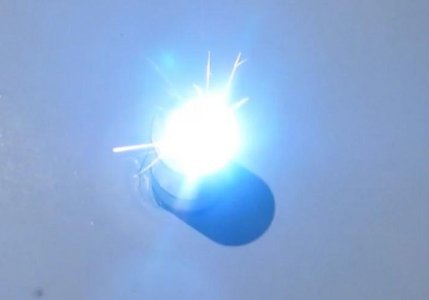 |
